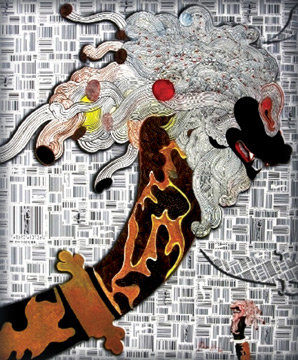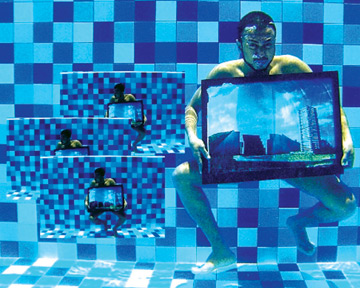Beware: Wet ink!
by G.R. Constantine
The epistemic break that dislodged Sri Lankan art from its modernist
idiom of art-thinking and art-making came about in the 1990 decade with
the 90s art trend which allowed a critical way of approaching visual art
and its art-making processes.
Modernism in Sri Lankan visual art, on the other hand, was ushered in
by the 43 Group, a radical and outward thinking group of artists who
made creative intrusions into the existing traditions of art-making
established within the British academic art protocols and practices by
incorporating interpretations of selective elements from European
Modernism and local art traditions fused in their art.
|

‘For Sale’by Pala Pothupitiya |
Although Sri Lankan art’s dislodgement from the 43 Group’s modernism
allowed contemporary thinking and practices to emerge in the 90s Art,
contemporary art has much to be indebted for making the boundaries of
visual art porous at these early stages where Lionel Wendt did what he
did with photography and Justin Daraniyagala did what he did with
painting.
Violence
From the early ‘80s, the change of socio-political contexts and the
overwhelming memories of violence in day to day life brought about a
major shift in the contents and expressiveness of all forms of arts and
literature in Sri Lanka.
For almost three decades a single week did not pass without an
incidence of violence, and the media bombarded their viewers and readers
with news of violence on a daily basis.
This had a major impact on visual art production in the ‘90s and the
decade that followed. In the visual art scene, this point of departure
was marked by Jagath Weerasinghe’s trend-setting 1992 exhibition
‘Anxiety.’
This was followed by an array of young artists whose art thematically
explored anxiety and anguish in paintings and other forms of visual
arts. This context gave rise to the installation art and performance art
practices in Sri Lanka.
With the end of terrorism in 2009, though numerous political
conflicts and crises remain unsettled, people are experiencing a new
wave of development in a relatively calm environment. A new era of
cultural ventures has dawned as evidenced by art biennales, dance
platforms, music festivals and literary festivals which have become a
regular feature in the cultural diary of Sri Lanka.
In keeping with the trends of globalisation, photography and
hyperrealism, multimedia installation art, new media creations and
digital representations have gradually found their way into the
consciousness of Sri Lanka’s art viewing public.
The hybrid forms of art practices fusing a multitude of art forms are
increasingly being adopted by artists since recent times. This was quite
evident in the Colombo Art Biennale held in 2014 with the virtual
absence of pure paintings (without fusion) in the whole biennale.
The use of new media is not a new phenomenon; it has been practised
by various artists for a long time. However, there certainly is a
pronounced surge in the use of mixed media and new media by artists in
their art productions in the recent times.
Economy
The impact of the liberalised economy and globalisation since the
opening of the Sri Lankan economy in 1977 is evident in contemporary Sri
Lankan art. This has the potential to gradually propel Sri Lankan art
from being ‘ethnic art’ to global art.
The ‘New Media Art’ has slowly started to emerge in Sri Lankan art
scene. Pradeep Thalawththa, Jananda Laksiri and Danushka Marasinghe are
from the younger generation of multimedia/IT competent artists who have
already shown promise in taking the Sri Lankan art to a new level.
However, its financial constrains remain the main obstacle in moving
towards full scale ‘New Media Art’ practice as most of the art products
of this genre are non-sellable art with high cost involved in its
production. Corporate sponsorship is the key to the further development
of art in Sri Lanka.
In this backdrop a group of artists who have been active from the
‘90s onwards in the Sri Lankan art scene presented their recent works
using digital technology in art production in this exhibition
appropriately titled ‘Beware: Wet Ink’. Marcel Duchamp used the phrase
‘Beware Wet Paint’ to remind us that it takes time to judge the worth of
work.
True to this statement the art products at this exhibition were
experiments in the way artists used their art methodologies, and had
opted to go beyond their comfortable boundaries of art-making.
|

Diyatha Uuyana by Pradeep Thalawatte |
The art works presented in the exhibition were from wide variety of
themes and styles. Pradeep Thalawaththa’s work titled Diyatha Uyana
depicted the artists struggling underwater holding a picture of ‘shrine
of the innocence’ which was demolished to create the Diyatha Uuyana in
the process of development. This was a very powerful work to illustrate
how history can be submerged and forgotten in the process of
development.
Identity
The ‘identity’ issue was analysed through a photo performance of
Bandu Mananperi under the title “Me and myself”. This work showed the
naked back of the artist with the reflection on the mirror showing the
artist wearing underwear. This is perhaps an effort to portray that the
identity that we assume is actually a reflection about ourselves that we
learn from other than our actual self.
Jagath Weerasinghe and Constantine used artistic intervention on
familiar war pictures to bring about a subtle political commentary. Pala
Pothupitiya presented a massive work where he critiqued the
commercialisation of cultural symbols. Anoli Perera, Dominic Sansoni,
Laki Senanayake, Pradeep Chandrasiri, Jananda Laksiri, Menika Van Der
Poorten, Pushpakumara, Danushka Marasinghe, Thisath Thoradeniya, Sarath
Kumarasiri and Anura Kirishantha were also represented in this
exhibition.
In many ways, ‘Beware: Wet Ink’ represented as connoted in the title
of exhibition itself, an element of surprise, an unexpected and above
all a ‘newness’ of a trope Participating artists represented different
generations and genres in art; but they were united in their quest to
explore a relatively new medium in their creative process. that is still
in the process of grasping and mastering by the artists and the
audiences. |

